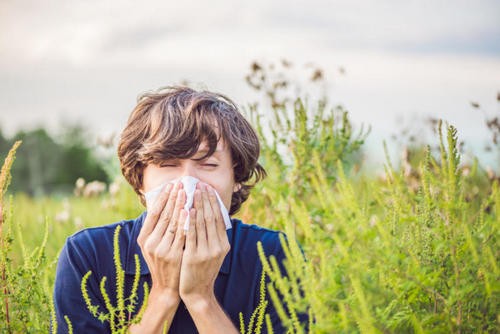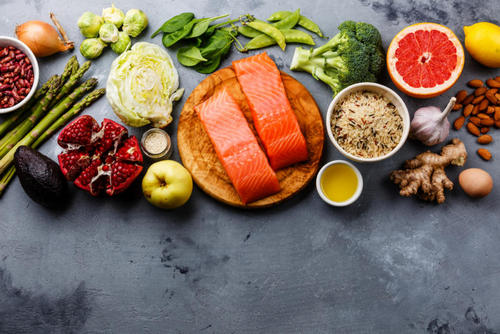Hypoallergenic diet for patients allergic to pollen from cereal grasses. What you can’t do: cereals and cereals, bran, baked goods, sausages, canned meat, dry mixes for making sauces, honey and bee products, beer, whiskey, wheat vodka, kvass, coffee substitutes based on wheat, cocoa, strawberries, strawberries, citrus fruits, soybeans, beans, peanuts, corn, sorrel, cereal herbal remedies.
Hypoallergenic diet for patients allergic to weed pollen. What is impossible: honey and bee products, sunflower seeds and sunflower oil, mustard, mayonnaise, melons (melon, watermelon), zucchini, eggplant, tomatoes, potatoes, spirits, tarragon, herbs and spices, chicory, citrus fruits, bananas, garlic, carrots, beets, spinach.
Hypoallergenic diet for patients with allergies to tree pollen. What is impossible: honey and bee products, stone fruits, apples, pears, kiwi, nuts, carrots, herbs, spices, brandy, wine, birch sap, potatoes, tomatoes, cucumbers, onions.
Spring is the perfect time of the year only if you are not allergic. Alas, for some people the appearance of blooming gardens does not cause joy, but tears from the eyes and sneezing. This year, spring allergies were especially strong. The prolonged cold delayed the flowering of many plants, and now, when the warm weather began to set, they all bloomed (or even bloom) almost simultaneously.

The cause of spring allergies (or hay fever, as doctors call it) is the pollen of flowering plants. These are the smallest particles that are easily carried by the wind, and in the spring for several weeks the air is literally filled with them. Pollen itself is safe, but in some people, the immune system mistakenly starts attacking particles of pollen that enter the body. This affects mainly the eyes and nose, as their surfaces are very sensitive, and pollen is not protected from ingestion. As a result, inflammation develops , which causes lacrimation, runny nose, and other allergy symptoms. Allergenic may be the pollen of a single plant or several.
Myth number 1. Pollinosis causes poplar fluff
Poplar fluff itself extremely rarely causes an allergic reaction, but its main danger is that it is able to carry pollen and spores of allergenic plants on itself, which include:
- trees and shrubs (birch, alder, hazel, willow, oak, chestnut, poplar, ash, elm);
- cereal grasses (timothy grass, ryegrass, fescue, foxtail, bluegrass, wheat grass, rye, wheat);
- weeds (quinoa, ragweed, hemp, nettle, wormwood).
Myth number 2. Hay fever exacerbates in spring when everything blooms
Depending on which strip of Russia you live in, hay fever symptoms can occur both in spring and summer (and even in autumn). If you are allergic, you need to know your allergenic plants and their flowering periods well.

In Russia, there are three peaks of exacerbations of hay fever:
- spring (April -May), due to the pollen of trees;
- summer (June – August) associated with pollen from cereal plants;
- Autumn (August – October), caused by pollen from weeds (ragweed, wormwood).
Myth number 3. Allergy is a hereditary disease
Of course, a hereditary predisposition plays an important role in the development of an allergic disease. The risk increases if someone in the family is already suffering from an allergy. If both parents are allergic, then the likelihood of developing an allergy in their child increases to 70-80%. However, even if none of the relatives have an allergy, the risk of its development is 15-20%, which is associated with a violation of the environmental situation, the quality of food consumed, a large number of preservatives in it, as well as irrational and uncontrolled intake of drugs, which leads to a change in condition our immune system.
Myth number 4. If there was no allergy since childhood, then it means it will not be
Most often, the first signs of an allergy occur between the ages of 5 and 20 years. However, it can also appear at an older age, which may be due to a person moving to another climatic zone where allergenic plants bloom (which a person might not even have guessed – there was no allergy before). Also, a person can live with allergies for many years, mistakenly considering it a banal runny nose, a cold or bronchitis. As soon as you notice symptoms such as itchy nose, itchy eyes, lacrimation, indomitable sneezing, runny nose, cough or shortness of breath, consult a specialist immediately. Such complaints can be the beginning of the development of hay fever.
Myth number 5. An allergy is when you sneeze a lot and watery eyes
Of course, the most common manifestation of hay fever is itching in the nose, nasal mucus, sneezing (so-called allergic rhinitis), lacrimation, redness of the eyes (allergic conjunctivitis). People with allergies may suddenly experience coughing, shortness of breath, shortness of breath – this may indicate pollen bronchial asthma already beginning.
However, for pollinosis, skin manifestations in the form of urticaria, Quincke’s edema, various dermatitis, blisters, and skin itching are also possible. Much less often, but nevertheless, sometimes there is a lesion of the urogenital tract in the form of vulvovaginitis, urethritis, cystitis or nephritis, as well as damage to the gastrointestinal tract, which can manifest itself in the form of nausea, vomiting and pain in the abdomen.
Myth number 6. It is impossible to recover from allergies
Most anti-allergic drugs are aimed at relieving the symptoms of the disease, and not at treating its cause. Today, the ASIT method (allergen-specific immunotherapy) is the only treatment method that treats the very cause of the disease, and after the termination of the course of therapy, the symptoms of the disease do not resume, but a long-term stable remission is observed. In the process of ASIT, complex reactions are carried out in the body’s immune system, as a result of which the immune response is switched from allergic to normal.
Myth number 7. Allergy is harmless in principle and can be left untreated.
An allergy must be treated, and under the guidance of a specialist – an allergist-immunologist. Unfortunately, many people have been self-medicating for many years, not even suspecting that inadequate treatment of hay fever can lead to the development of serious complications: sinusitis (inflammation in the sinuses), otitis media (inflammation of the middle ear), the formation of cysts of the paranasal sinuses, polyps, and also to pollen bronchial asthma.
Myth number 8. Allergological examination is very expensive
For a competent specialist, it will be enough to talk with you in detail, ask specific questions, direct you to the necessary research and conduct a series of tests. This will be quite enough to identify specific allergens that cause an allergic reaction in you.
All the basic tests you need to detect hay fever are covered by standard health insurance. You just need to go to the district allergist, tell him in detail about your complaints, and he will give directions for the necessary tests and studies.
Here are 20 tips that you need to follow in order to protect yourself from hay fever, to survive this spring normally and to live life to the fullest, although before it seemed that in the flowering season it was simply impossible:
-
- Try to stay home on dry, windy days. In this weather, the most pollen is in the air. On the contrary, after the rain it becomes much smaller, so this is the best time to walk or go shopping.
- When going out, wear sunglasses. This will partly help protect your eyes from pollen, which irritates them.
- Close the windows in the car during the trip, especially outside the city.
- In principle, try not to leave the city during the period of active flowering, since outside the city the pollen concentration of some plants and trees is much higher than in the city. Also, lovers to work on the beds in the garden or on the beds of their garden are recommended to postpone these classes until the end of the hay fever season.
- Returning home, take a shower and take away street clothes away. The smallest pollen particles that support allergies remain on your body and clothing.
- Dry washed clothing indoors. This is not worth doing on the street: there, pollen of flowering plants can stick to it, which will cause allergies as soon as you wear these clothes.
- Use air conditioning in the car and at home. There are special air filters that trap allergens. Clean your home regularly by collecting dust with a vacuum cleaner (there are anti-allergenic HEPA filters for them).
- Sleep with your windows closed.
- Watch out for pets. If you let them walk outside, pollen can also accumulate on their wool, which they will bring to your home.
- Take a shower and wash your hair before bed. This will cleanse your skin and hair of allergens adhering to them in a day. The likelihood of nighttime allergy attacks will decrease markedly.
- As agreed with your doctor, start taking OTC drugs. With spring allergies, antihistamines usually help. It is preferable to use antihistamines of 2 and 3 generations (loratadine, levocetirizine and others), since they are safer and less likely to cause drowsiness.
- Irrigate the nasal cavity with saline or distilled water. This will relieve nasal congestion and immediately wash allergens and mucus out of it.
- The best way to deal with spring allergies is with allergen-specific immunotherapy. During it, the doctor will first determine what exactly causes you allergies, and then make a series of subcutaneous injections. They will allow the body to gradually “get used” to the allergen and reduce the severity of symptoms. Such injections should be done in advance, before the allergy season has yet begun.
- Avoid psycho-emotional and heavy physical exertion.
- If possible, go to the climate zone with a different dusting calendar, to the sea coast or to the mountains, where pollen concentrations are much lower. Plan your vacation by knowing in advance the timing of flowering of allergenic plants in the area of your chosen vacation spot.
- In case of exacerbation of hay fever, postpone the execution of planned operations, preventive vaccinations and vaccinations.
- Do not use medicines, cosmetics, homeopathic medicines or herbal medicine if they contain extracts of plants allergenic for you.
- Always carry the “Allergic Disease Patient Passport” with you, which your allergist will give you after consultation and examination. The passport will show your surname, name and patronymic, date of birth, allergic diagnosis, a range of allergens to which you have been identified as sensitive, and a list of measures to eliminate contact with the allergen. The passport provides a list of medicines that should always be in your medicine cabinet, indicates the order of measures in the event of anaphylactic shock and the order of use of drugs.
- Begin to keep a “Diary of a patient with hay fever”, in which it is necessary to indicate the start date of the onset of symptoms, how pronounced they were, what treatment you used, indicating the doses of drugs and the frequency of their use, as well as the date of disappearance of allergy symptoms.
- In the period of exacerbation of hay fever, it is necessary to observe a specific hypoallergenic diet, the composition of which depends on the type of hay fever.

More than half of patients with hay fever respond to foods that have similar characteristics to pollen allergens. A so-called cross allergic reaction develops. That is why patients are advised to adhere to a special hypoallergenic diet.



